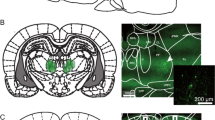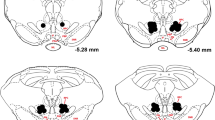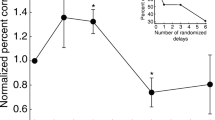Abstract
Rationale
The central serotonergic systems are a major target for drugs used to treat neuropsychiatric disorders such as depression and schizophrenia in which disruption of frontal cortex function has been implicated. However, it is not known precisely how serotonin (5-HT) modulates the medial prefrontal cortex (mPFC) to affect cognitive function and behaviour.
Objective
To investigate the roles of 5-HT1A and 5-HT2A receptors in mPFC on performance of the five-choice serial reaction time task (5CSRT), which assesses visuospatial attention, impulsivity and motivational processes.
Methods
Following training on the 5CSRT, rats were implanted with bilateral guide cannulae aimed at the mPFC. Rats received intra-mPFC infusions of either 8-OH-DPAT (10, 30 and 100 ng) or M100907 (30, 100 and 300 ng) according to a Latin square design.
Results
Both 8-OH-DPAT and M100907 selectively enhanced accuracy of target detection. When the stimulus duration was shortened, infusions of 8-OH-DPAT continued to improve accuracy, whereas M100907 decreased premature responding and omissions, thus partly dissociating the effects of these two compounds. Similar effects were obtained following systemic administration of M100907 and 8-OH-DPAT. The effects of 8-OH-DPAT were blocked by the 5-HT1A antagonist WAY 100635, at a dose that itself had no significant effects on behaviour.
Conclusions
These results indicate that modulation of 5-HT function within the mPFC via distinct receptors can enhance performance on the 5CSRT. These findings suggest a mechanism by which serotonergic agents improve cognitive function, which may be relevant to their therapeutic benefit in the treatment of neuropsychiatric disorders.






Similar content being viewed by others
References
Aghajanian GK, Marek GJ (1999a) Serotonin, via 5-HT2A receptors, increases EPSCs in layer V pyramidal cells of prefrontal cortex by an asynchronous mode of glutamate release. Brain Res 825:161–171
Aghajanian GK, Marek GJ (1999b) Serotonin-glutamate interactions: a new target for antipsychotic drugs. Neuropsychopharmacology 21:S122–S133
Araneda R, Andrade R (1991) 5-hydroxytryptamine2 and 5-hydroxytryptamine1A receptors mediate opposing responses on membrane excitability in rat- association cortex. Neuroscience 40:399–412
Arborelius L, Nomikos GG, Hacksell U, Svensson TH (1993) (R)-8-OH-DPAT preferentially increases dopamine release in rat medial prefrontal cortex. Acta Physiol Scand 148:465–466
Ashby CR, Edwards E, Wang RY (1994) Electrophysiological evidence for a functional interaction between 5-HT1A and 5-HT2A receptors in the rat medial prefrontal cortex—an iontophoretic study. Synapse 17:173–181
Assie MB, Koek W (2000) [3H]-8-OH-DPAT binding in the rat brain raphe area: involvement of 5-HT1A and non-5-HT1A receptors. Br J Pharmacol 130:1348–1352
Backus LI, Sharp T, Grahamesmith DG (1990) Behavioral evidence for a functional interaction between central 5-HT2-receptor and 5-HT1A-receptor. Br J Pharmacol 100:793–799
Barnes NM, Sharp T (1999) A review of central 5-HT receptors and their function. Neuropharmacology 38:1083–1152
Berendsen HHG, Broekkamp CLE (1990) Behavioral evidence for functional interactions between 5-HT-receptor subtypes in rats and mice. Br J Pharmacol 101:667–673
Bianchi C, Siniscalchi A, Beani L (1990) 5-HT1A agonists increase and 5-HT3 agonists decrease acetylcholine efflux from the cerebral-cortex of freely moving guinea-pigs. Br J Pharmacol 101:448–452
Blier P, Demontigny C (1987) Modification of 5-HT neuron properties by sustained administration of the 5-HT1A agonist gepirone—electrophysiological studies in the rat-brain. Synapse 1:470–480
Bonvento G, Scatton B, Claustre Y, Rouquier L (1992) Effect of local injection of 8-OH-DPAT into the dorsal or median raphe nuclei on extracellular levels of serotonin in serotonergic projection areas in the rat-brain. Neurosci Lett 137:101–104
Carli M, Samanin R (1992) Serotonin2 receptor agonists and serotonergic anorectic drugs affect rats performance differently in a 5-choice serial reaction time task. Psychopharmacology 106:228–234
Carli M, Samanin R (2000) The 5-HT1A receptor agonist 8-OH-DPAT reduces rats' accuracy of attentional performance and enhances impulsive responding in a five-choice serial reaction time task: role of presynaptic 5-HT1A receptors. Psychopharmacology 149:259–268
Carli M, Robbins TW, Evenden JL, Everitt BJ (1983) Effects of lesions to ascending noradrenergic neurons on performance of a 5-choice serial reaction task in rats—implications for theories of dorsal noradrenergic bundle function based on selective attention and arousal. Behav Brain Res 9:361–380
Casanovas JM, Hervas I, Artigas F (1999) Postsynaptic 5-HT1A receptors control 5-HT release in the rat medial prefrontal cortex. Neuroreport 10:1441–1445
Celada P, Puig MV, Casanovas JM, Guillazo G, Artigas F (2001) Control of dorsal raphe serotonergic neurons by the medial prefrontal cortex: involvement of serotonin-1A, GABAA, and glutamate receptors. J Neurosci 21:9917–9929
Christakou A, Robbins TW, Everitt BJ (2001) Functional disconnection of a prefrontal cortical–dorsal striatal system disrupts choice reaction time performance: implications for attentional function. Behav Neurosci 115:812–825
Cole BJ, Jones GH, Turner JD (1994) 5-HT1A receptor agonists improve the performance of normal and scopolamine-impaired rats in an operant delayed matching to sample task. Psychopharmacology 116:135–142
Consolo S, Ramponi S, Ladinsky H, Baldi G (1996) A critical role for D1 receptors in the 5-HT1A-mediated facilitation of in vivo acetylcholine release in rat frontal cortex. Brain Res 707:320–323
Dalley JW, McGaughy J, O'Connell MT, Cardinal RN, Levita L, Robbins TW (2001) Distinct changes in cortical acetylcholine and noradrenaline efflux during contingent and noncontingent performance of a visual attentional task. J Neurosci 21:4908–4914
Dalley JW, Theobald DE, Eagle DM, Passetti F, Robbins TW (2002) Deficits in impulse control associated with tonically-elevated serotonergic function in rat prefrontal cortex. Neuropsychopharmacology 26:716–728
Darmani NA, Martin BR, Pandey U, Glennon RA (1990) Do functional relationships exist between 5-HT1A and 5-HT2 receptors. Pharmacol Biochem Behav 36:901–906
Day J, Fibiger HC (1993) Dopaminergic regulation of cortical acetylcholine release—effects of dopamine receptor agonists. Neuroscience 54:643–648
Dursun SM, Handley SL (1993) The effects of alpha-2-adrenoceptor antagonists on the inhibition of 1-(2,5-dimethoxy-4-iodophenyl)-2-aminopropane (DOI)-induced head shakes by 5-HT1A receptor agonists in the mouse. Br J Pharmacol 109:1046–1052
Evenden JL (1999a) The pharmacology of impulsive behaviour in rats. VII. The effects of serotonergic agonists and antagonists on responding under a discrimination task using unreliable visual stimuli. Psychopharmacology 146:422–431
Evenden JL (1999b) Varieties of impulsivity. Psychopharmacology 146:348–361
Everitt BJ, Robbins TW (1997) Central cholinergic systems and cognition. Annu Rev Psychol 48:649–684
File SE, Gonzalez LE, Andrews N (1996) Comparative study of pre- and postsynaptic 5-HT1A receptor modulation of anxiety in two ethological animal tests. J Neurosci 16:4810–4815
Fletcher PJ, Grottick AJ, Higgins GA (2002) Differential effects of the 5-HT2A receptor antagonist M100,907 and the 5-HT2C receptor antagonist SB242,084 on cocaine-induced locomotor activity, cocaine self-administration and cocaine-induced reinstatement of responding. Neuropsychopharmacology 27:576–586
Fuller RW, Snoddy HD (1987) Influence of route of administration on potency of the selective 5-HT1A agonist 8-hydroxy-2-(di-N-propylamino) tetralin in rats. Res Commun Chem Pathol Pharmacol 58:409–412
Gillet G, Ammor S, Fillion G (1985) Serotonin inhibits acetylcholine release from rat striatum slices—evidence for a presynaptic receptor-mediated effect. J Neurochem 45:1687–1691
Gobert A, Rivet JM, Audinot V, Newman-Tancredi A, Cistarelli L, Millan MJ (1998) Simultaneous quantification of serotonin, dopamine and noradrenaline levels in single frontal cortex dialysates of freely-moving rats reveals a complex pattern of reciprocal auto- and heteroreceptor-mediated control of release. Neuroscience 84:413–429
Goldman-Rakic PS, Selemon LD (1997) Functional and anatomical aspects of prefrontal pathology in schizophrenia. Schizophr Bull 23:437–458
Granon S, Passetti F, Thomas KL, Dalley JW, Everitt BJ, Robbins TW (2000) Enhanced and impaired attentional performance after infusion of D1 dopaminergic receptor agents into rat prefrontal cortex. J Neurosci 20:1208–1215
Gundlah C, Hjorth S, Auerbach SB (1997) Autoreceptor antagonists enhance the effect of the reuptake inhibitor citalopram on extracellular 5-HT: this effect persists after repeated citalopram treatment. Neuropharmacology 36:475–482
Hajos M, Richards CD, Szekely AD, Sharp T (1998) An electrophysiological and neuroanatomical study of the medial prefrontal cortical projection to the midbrain raphe nuclei in the rat. Neuroscience 87:95–108
Hajos M, Hajos Korcsok E, Sharp T (1999) Role of the medial prefrontal cortex in 5-HT1A receptor-induced inhibition of 5-HT neuronal activity in the rat. Br J Pharmacol 126:1741–1750
Harel-Dupas C, Cloez I, Fillion G (1991) The inhibitory effect of trifluoromethylphenylpiperazine on [3H]acetylcholine-release in guinea-pig hippocampal synaptosomes is mediated by a 5-hydroxytryptamine1 receptor distinct from 1A-subtype, 1B-subtype, and 1C-subtype. J Neurochem 56:221–227
Harrison AA, Everitt BJ, Robbins TW (1997a) Central 5-HT depletion enhances impulsive responding without affecting the accuracy of attentional performance: interactions with dopaminergic mechanisms. Psychopharmacology 133:329–342
Harrison AA, Everitt BJ, Robbins TW (1997b) Doubly dissociable effects of median- and dorsal-raphe lesions on the performance of the five-choice serial reaction time test of attention in rats. Behav Brain Res 89:135–149
Hoyer D, Clarke DE, Fozard JR, Hartig PR, Martin GR, Mylecharane EJ, Saxena PR, Humphrey PPA (1994) International union of pharmacology classification of receptors for 5-hydroxytryptamine (serotonin). Pharmacol Rev 46:157–203
Ichikawa J, Meltzer HY (1999) Relationship between dopaminergic and serotonergic neuronal activity in the frontal cortex and the action of typical and atypical antipsychotic drugs. Eur Arch Psych Clin Neurosci 249:90–98
Ichikawa J, Ishii H, Bonaccorso S, Fowler WL, O'Laughlin IA, Meltzer HY (2001) 5-HT2A and D2 receptor blockade increases cortical DA release via 5-HT1A receptor activation: a possible mechanism of atypical antipsychotic-induced cortical dopamine release. J Neurochem 76:1521–1531
Ichikawa J, Dai J, Meltzer HY (2002a) 5-HT1A and 5-HT2A receptors minimally contribute to clozapine-induced acetylcholine release in rat medial prefrontal cortex. Brain Res 939:34–42
Ichikawa J, Dai J, O'Laughlin IA, Fowler WL, Meltzer HY (2002b) Atypical, but not typical, antipsychotic drugs increase cortical acetylcholine release without an effect in the nucleus accumbens or striatum. Neuropsychopharmacology 26:325–339
Kehne JH, Baron BM, Carr AA, Chaney SF, Elands J, Feldman DJ, Frank RA, VanGiersbergen PLM, McCloskey TC, Johnson MP, McCarty DR, Poirot M, Senyah Y, Siegel BW, Widmaier C (1996) Preclinical characterization of the potential of the putative atypical antipsychotic MDL 100,907 as a potent 5-HT2A antagonist with a favorable CNS safety profile. J Pharmacol Exp Ther 277:968–981
Kia HK, Miquel MC, Brisorgueil MJ, Daval G, Riad M, ElMestikawy S, Hamon M, Verge D (1996) Immunocytochemical localization of serotonin1A receptors in the rat central nervous system. J Comp Neurol 365:289–305
Koskinen T, Sirvio J (2001) Studies on the involvement of the dopaminergic system in the 5-HT2 agonist (DOI)-induced premature responding in a five-choice serial reaction time task. Brain Res Bull 54:65–75
Koskinen T, Ruotsalainen S, Puumala T, Lappalainen R, Koivisto E, Mannisto PT, Sirvio J (2000) Activation of 5-HT2A receptors impairs response control of rats in a five-choice serial reaction time task. Neuropharmacology 39:471–481
Leysen JE, Janssen PMF, Schotte A, Luyten W, Megens A (1993) Interaction of antipsychotic-drugs with neurotransmitter receptor-sites in-vitro and in-vivo in relation to pharmacological and clinical effects—role of 5HT2 receptors. Psychopharmacology 112:S40–S54
Linnoila M, Virkkunen M, Scheinin M, Nuutila A, Rimon R, Goodwin FK (1983) Low cerebrospinal-fluid 5-hydroxyindoleacetic acid concentration differentiates impulsive from nonimpulsive violent behavior. Life Sci 33:2609–2614
Martin-Ruiz R, Puig MV, Celada P, Shapiro DA, Roth BL, Mengod G, Artigas F (2001) Control of serotonergic function in medial prefrontal cortex by serotonin-2A receptors through a glutamate-dependent mechanism. J Neurosci 21:9856–9866
Maura G, Fedele E, Raiteri M (1989) Acetylcholine-release from rat hippocampal slices is modulated by 5-hydroxytryptamine. Eur J Pharmacol 165:173–179
McGaughy J, Dalley JW, Morrison CH, Everitt BJ, Robbins TW (2002) Selective behavioral and neurochemical effects of cholinergic lesions produced by intrabasalis infusions of 192 IgG-saporin on attentional performance in a five-choice serial reaction time task. J Neurosci 22:1905–1913
McGurk SR, Meltzer HY (2000) The role of cognition in vocational functioning in schizophrenia. Schizophr Res 45:175–184
Meltzer HY (1999) The role of serotonin in antipsychotic drug action. Neuropsychopharmacology 21:S106–S115
Meltzer HY, McGurk SR (1999) The effects of clozapine, risperidone, and olanzapine on cognitive function in schizophrenia. Schizophr Bull 25:233–255
Meltzer HY, Park S, Kessler R (1999) Cognition, schizophrenia, and the atypical antipsychotic drugs. Proc Natl Acad Sci USA 96:13591–13593
Meneses A (1999) 5-HT system and cognition. Neurosci Biobehav Rev 23:1111–1125
Millan MJ (2000) Improving the treatment of schizophrenia: focus on serotonin 5-HT1A receptors. J Pharmacol Exp Ther 295:853–861
Mobini S, Chiang TJ, Ho MY, Bradshaw CM, Szabadi E (2000) Effects of central 5-hydroxytryptamine depletion on sensitivity to delayed and probabilistic reinforcement. Psychopharmacology 152:390–397
Moghaddam B, Bunney BS (1990) Acute effects of typical and atypical antipsychotic drugs on the release of dopamine from prefrontal cortex, nucleus accumbens, and striatum of the rat—an in vivo microdialysis study. J Neurochem 54:1755–1760
Muir JL, Page KJ, Sirinathsinghji DJS, Robbins TW, Everitt BJ (1993) Excitotoxic lesions of basal forebrain cholinergic neurons—effects on learning, memory and attention. Behav Brain Res 57:123–131
Muir JL, Everitt BJ, Robbins TW (1994) AMPA-induced excitotoxic lesions of the basal forebrain—a significant role for the cortical cholinergic system in attentional function. J Neurosci 14:2313–2326
Muir JL, Everitt BJ, Robbins TW (1996) The cerebral cortex of the rat and visual attentional function: dissociable effects of mediofrontal, cingulate, anterior dorsolateral, and parietal cortex lesions on a five-choice serial reaction time task. Cereb Cortex 6:470–481
Newman-Tancredi A, Gavaudan S, Conte C, Chaput C, Touzard M, Verriele L, Audinot V, Millan MJ (1998) Agonist and antagonist actions of antipsychotic agents at 5-HT1A: a [35S]GTPgammaS binding study. Eur J Pharmacol 355:245–256
Passetti F, Dalley JW, O'Connell MT, Everitt BJ, Robbins TW (2000) Increased acetylcholine release in the rat medial prefrontal cortex during performance of a visual attentional task. Eur J Neurosci 12:3051–3058
Passetti F, Dalley JW, Robbins TW (2003) Double dissociation of serotonergic and dopaminergic mechanisms on attentional performance using a rodent five-choice reaction time task. Psychopharmacology 165:136–145
Paxinos G, Watson C (1998) The rat brain in stereotaxic co-ordinates, 4th edn. Academic Press, New York
Pazos A, Palacios JM (1985) Quantitative autoradiographic mapping of serotonin receptors in the rat-brain.1. Serotonin-1 receptors. Brain Res 346:205–230
Peroutka SJ (1986) Pharmacological differentiation and characterization of 5-HT1A, 5-HT1B and 5-HT1C binding sites in rat frontal cortex. J Neurochem 47:529–540
Perry KW, Fuller RW (1989) Determination of brain concentrations of 8-hydroxy-2-(di-normal-propylamino)tetralin by liquid chromatography with electrochemical detection. Biochem Pharmacol 38:3169–3173
Quirion R, Richard J, Dam TV (1985) Evidence for the existence of serotonin type-2 receptors on cholinergic terminals in rat cortex. Brain Res 333:345–349
Robbins TW (2000) Chemical neuromodulation of frontal-executive functions in humans and other animals. Exp Brain Res 133:130–138
Rocha BA, Goulding EH, O'Dell LE, Mead AN, Coufal NG, Parsons LH, Tecott LH (2002) Enhanced locomotor, reinforcing, and neurochemical effects of cocaine in serotonin 5-hydroxytryptamine 2C receptor mutant mice. J Neurosci 22:10039–10045
Rollema H, Lu Y, Schmidt AW, Zorn SH (1997) Clozapine increases dopamine release in prefrontal cortex by 5-HT1A receptor activation. Eur J Pharmacol 338:R3–R5
Ruotsalainen S, Sirvio J, Jakala P, Puumala T, MacDonald E, Riekkinen P (1997) Differential effects of three 5-HT receptor antagonists on the performance of rats in attentional and working memory tasks. Eur Neuropsychopharmacol 7:99–108
Sakaue M, Somboonthum P, Nishihara B, Koyama Y, Hashimoto H, Baba A, Matsuda T (2000) Postsynaptic 5-hydroxytryptamine1A receptor activation increases in vivo dopamine release in rat prefrontal cortex. Br J Pharmacol 129:1028–1034
Samanin R, Quattrone A, Consolo S, Ladinsky H, Algen S (1978) Biochemical and pharmacological evidence of the interaction of serotonin with other aminergic systems in the brain. In: Garattini S, Pujol JF, Samanin R (eds) Interactions between putative neurotransmitters in the brain. Ravens Press, New York, pp 383–399
Sarter M, Bruno JP (2000) Cortical cholinergic inputs mediating arousal, attentional processing and dreaming: differential afferent regulation of the basal forebrain by telencephalic and brainstem afferents. Neuroscience 95:933–952
Scruggs JL, Patel S, Bubser M, Deutch AY (2000) DOI-induced activation of the cortex: dependence on 5-HT2A heteroceptors on thalamocortical glutamatergic neurons. J Neurosci 20:8846–8852
Sharp T, Backus LI, Hjorth S, Bramwell SR, Grahame-Smith DG (1990) Further investigation of the in vivo pharmacological properties of the putative 5-HT1A antagonist, BMY 7378. Eur J Pharmacol 176:331–340
Siniscalchi A, Beani L, Bianchi C (1990) Different effects of 8-OH-DPAT, a 5-HT1A receptor agonist, on cortical acetylcholine release, electrocortigram and body temperature in guinea pigs and rats. Eur J Pharmacol 175:219–223
Sorensen SM, Kehne JH, Fadayel GM, Humphreys TM, Ketteler HJ, Sullivan CK, Taylor VL, Schmidt CJ (1993) Characterization of the 5-HT2 receptor antagonist MDL 100907 as a putative atypical antipsychotic—behavioral, electrophysiological and neurochemical studies. J Pharmacol Exp Ther 266:684–691
Soubrié P (1986) Reconciling the role of central serotonin neurons in human and animal behavior. Behav Brain Sci 9:319–364
Steele TD, Hodges DB, Levesque TR, Locke KW (1997) D1 agonist dihydrexidine releases acetylcholine and improves cognitive performance in rats. Pharmacol Biochem Behav 58:477–483
Tanda G, Carboni E, Frau R, Dichiara G (1994) Increase of extracellular dopamine in the prefrontal cortex—a trait of drugs with antidepressant potential. Psychopharmacology 115:285–288
Tandon R (1999) Cholinergic aspects of schizophrenia. Br J Psychiatry 174:7–11
Verge D, Daval G, Marcinkiewicz M, Patey A, el Mestikawy S, Gozlan H, Hamon M (1986) Quantitative autoradiography of multiple 5-HT1 receptor subtypes in the brain of control or 5,7-dihydroxytryptamine-treated rats. J Neurosci 6:3474–3482
Warburton EC, Harrison AA, Robbins TW, Everitt BJ (1997) Contrasting effects of systemic and intracerebral infusions of the 5-HT1A receptor agonist 8-OH-DPAT on spatial short-term working memory in rats. Behav Brain Res 84:247–258
Williams GV, Rao SG, Goldman-Rakic PS (2002) The physiological role of 5-HT2A receptors in working memory. J Neurosci 22:2843–2854
Zilles K, Wree A (1995) Cortex: areal and laminar structure. In: Paxinos G (ed) The rat nervous system. Academic Press, London, pp 649–685
Acknowledgements
This work was supported by a Wellcome Trust programme grant and completed within the MRC Centre for Behavioural and Clinical Neuroscience. C.A.W. was supported by an MRC studentship.
Author information
Authors and Affiliations
Corresponding author
Rights and permissions
About this article
Cite this article
Winstanley, C.A., Chudasama, Y., Dalley, J.W. et al. Intra-prefrontal 8-OH-DPAT and M100907 improve visuospatial attention and decrease impulsivity on the five-choice serial reaction time task in rats. Psychopharmacology 167, 304–314 (2003). https://doi.org/10.1007/s00213-003-1398-x
Received:
Accepted:
Published:
Issue Date:
DOI: https://doi.org/10.1007/s00213-003-1398-x




